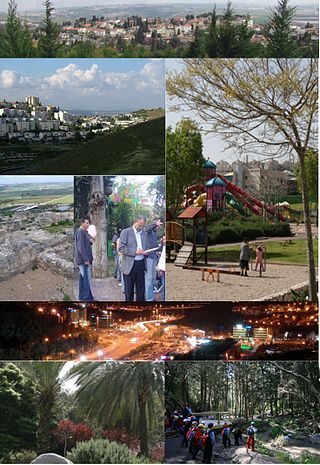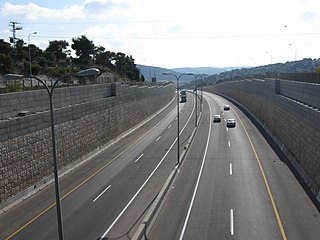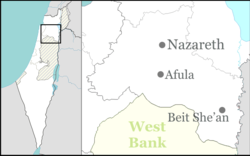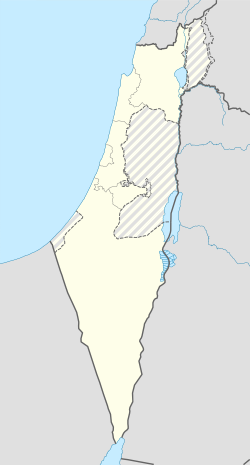
Nof HaGalil is a city in the Northern District of Israel with a population of 44,184.

Afula is a city in the Northern District of Israel, often known as the "Capital of the Valley" due to its strategic location in the Jezreel Valley. As of 2022, the city had a population of 61,519.

The Jezreel Valley, or Marj Ibn Amir, also known as the Valley of Megiddo, is a large fertile plain and inland valley in the Northern District of Israel. It is bordered to the north by the highlands of the Lower Galilee region, to the south by the Samarian highlands, to the west and northwest by the Mount Carmel range, and to the east by the Jordan Valley, with Mount Gilboa marking its southern extent. The largest settlement in the valley is the city of Afula, which lies near its center.

Yokneam Illit, also Yoqne'am Illit and Jokneam Illit, is a city in northern Israel. It is located in a hilly region of the Lower Galilee at the base of the Carmel Mountains, and overlooks the Jezreel Valley. It is 21 kilometres from Haifa and 80 kilometres (50 mi) from Tel Aviv. Yokneam is known as Israel's "Startup Village" because its high-tech hub is surrounded by forest and small communities.

Yehoshua Hankin was a Zionist activist who was responsible for most of the major land purchases of the Zionist Organization in Ottoman Palestine and Mandatory Palestine – in particular for the Sursock Purchase.

Ein HaShofet is a kibbutz in northern Israel. Located in the Menashe Heights region around 25 km southeast of the city of Haifa, close to Yokneam, it falls under the jurisdiction of Megiddo Regional Council. In 2022 it had a population of 864.

HaZore'a is a kibbutz in northern Israel established in 1936 by German Jews. It is the only kibbutz that was established by members of the Werkleute movement. Located in the western rim of the Jezreel Valley, it falls under the jurisdiction of Megiddo Regional Council. In 2022 it had a population of 930.

The Megiddo Regional Council is a regional council in northern Israel encompassing land on the Menashe Plateau, and partly in the Jezreel Valley. The council is bounded by the city of Yokneam Illit to the north, and the Carmel mountain range to the east, and houses about 9,600 people on nine kibbutzim, and four moshavim located in its municipal territory.

Mishmar HaEmek is a kibbutz in northern Israel. Located in the western Jezreel Valley, it falls under the jurisdiction of the Megiddo Regional Council. Mishmar HaEmek is one of the few kibbutzim that have not undergone privatization and still follow the traditional collectivist and socialist kibbutz model. In 2022, it had a population of 1,278. At least six former members of the Knesset hail from Mishmar HaEmek.

Qira was a Palestinian Arab village, located 23 kilometers southeast of Haifa. It was locally referred to as Qira wa Qamun.

Sarid is a kibbutz in northern Israel. Located near Migdal HaEmek, it falls under the jurisdiction of Jezreel Valley Regional Council. In 2022 it had a population of 889.

Kfar Yehoshua is a moshav in northern Israel. Located between Haifa and Nazareth, it falls under the jurisdiction of Jezreel Valley Regional Council. In 2022 it had a population of 1,251.

Ein HaEmek is a community settlement in northern Israel. Located near Yokneam, it falls under the jurisdiction of Megiddo Regional Council. In 2022 it had a population of 847.

Midrakh Oz is an agricultural moshav in northern Israel. Located in the Jezreel Valley, it falls under the jurisdiction of Megiddo Regional Council. In 2022 it had a population of 822, both religious and secular Jews.

Abu Zurayq is a cluster of archaeological sites at a well-watered spot at the western edge of the Jezreel Valley and its transition to the Menashe Heights, next to Highway 66, between the modern kibbutzim of HaZore'a and Mishmar HaEmek.

Ma'ayan Harod or Ain Jalut is an all-year spring in the Harod Valley on the northwest corner of Mount Gilboa, that was the location of the 13th-century Battle of Ain Jalut. This was a major turning point in world history that saw the Mamluks inflict the first of two defeats on the Mongols that ultimately halted their invasion of the Levant and Egypt.

Yokneam–Kfar Yehoshua railway station is an Israel Railways passenger station situated on the Jezreel Valley railway. The station serves Yokneam Illit, Kiryat Tiv'on, Ramat Yishai and the surrounding area. The station is located between Yokneam and Kfar Yehoshua, east of Highway 70 and south of Highway 722. It is served by one to two trains per hour in each direction.

Tel Yokneam, also spelled Yoqne'am or Jokneam, is an archaeological site located in the northern part of the modern city of Yokneam Illit, Israel. It is known in Arabic as Tell Qamun, believed to be a corruption of the Hebrew name. The site is an elevated mound, or tell, spanning around 40 dunams and rising steeply to a height of 60 meters (200 ft). With a few brief interruptions, Yokneam was occupied for 4,000 years, from the Middle Bronze Age to the Ottoman period.

The Sursock Purchases were land purchases made by Jewish organizations from the absentee landowning Lebanese Greek Orthodox Christian Sursock family, mainly from 1901 to 1925. These included the Jezreel Valley and Haifa Bay, as well as other lands in what became the Mandate for Palestine. These collectively formed the largest Jewish land purchase in Palestine during the period of early Jewish immigration.

Highway 67 is a highway in northern Israel and is one of the two main traffic arteries that cross the Carmel while connecting the coastal plain to Highway 6. The length of the road is 13 km (8.1 mi). The road starts at the Zikhron Ya'akov interchange and ends at the Ein Tut interchange at the junction with Highway 6.



























